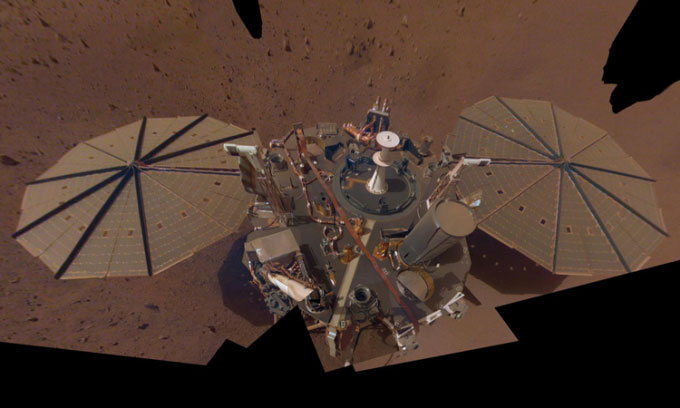NASA's Mars lander is about to 'die'
The InSight lander, which has been landing on Mars since 2018, is expected to shut down in the next few months due to low energy.
During about three and a half years on Mars, NASA's InSight lander has yielded valuable information about the interior of the red planet, recorded earthquakes and been active for much longer than originally planned. However, this lander is approaching its final days, as dust continues to accumulate on solar panels. On May 17, NASA released an estimated timetable for when it would stop working.

The InSight lander took a selfie in early 2019, when it was covered by a thin layer of dust.
"InSight will soon end its scientific life," said Bruce Banerdt, expert on InSight's team. The dust-covered solar panels forced the lander to operate with extremely limited electricity.
The team in charge is prioritizing power to the seismometer - an instrument that records the magnitude 5 "monster" earthquake in early May. NASA hopes the seismometer will continue to operate through the end of spring. Given current power limitations, it will most likely be shut down in July, when InSight ends its science mission. NASA plans to end all InSight operations by the end of 2022.
InSight landed on Mars in late 2018. When new and clean, the solar panels produced enough energy to run an electric furnace for about 1 hour and 40 minutes a day. Now, that number is down to about 10 minutes. NASA hopes a tornado will appear and clean InSight's solar panels, helping to increase electricity production, but that hasn't happened yet. Unpredictable weather on Mars can alter the schedule. A whirlwind can prolong the activity, while a dust storm shortens it.
InSight will spend some of its energy putting its robotic arm into a "retirement position," allowing the camera to see the seismometer. When the seismometer stops working, InSight will occasionally take pictures and communicate with Earth until the power is too low to maintain.
While the end of the mission can be sad, the team in charge doesn't feel too negative or bleak because there's still a lot of work to do with InSight, Banerdt said. The May earthquake - the largest earthquake ever recorded on another planet - shows that the lander can still provide remarkable data even when it is "dead".
InSight helps scientists map the interior of the red planet for the first time. "The lander gave us information we couldn't get from any other space vehicle in NASA's Mars 'army'," said Lori Glaze, director of the Planetary Science Division at NASA. , To share.
- The lander takes pictures of the sunrise on Mars
- Found lunar lander lost touch of India
- Historical photos transmitted from Mars
- Former NASA employee:
- Intense snowstorms appear at night on Mars
- India found the missing Moon amphibious ship
- NASA lost contact with Mars robots for two weeks
- America: The ship launches land on Mars
- Did the ocean on Mars get into the rock?
- NASA's 'window-throwing money' cases
- NASA explains the confusing
- Top 10 photos of Mars
 Announced 3 houses on the Moon and Mars
Announced 3 houses on the Moon and Mars Science proves: Mars also knows 'deflated'
Science proves: Mars also knows 'deflated' Elon Musk announced the price for a Mars trip was 11.6 billion VND, free of charge
Elon Musk announced the price for a Mars trip was 11.6 billion VND, free of charge NASA discovered strange 'gate' on Mars, is the hiding place found?
NASA discovered strange 'gate' on Mars, is the hiding place found?